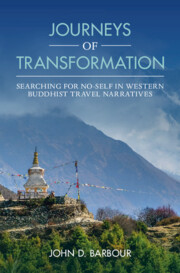Book contents
- Journeys of Transformation
- Reviews
- Journeys of Transformation
- Copyright page
- Dedication
- Contents
- Acknowledgments and Author’s Note
- Introduction A Literary Genre and Some Questions about Self-Transformation
- Chapter 1 The Origins of the Genre
- Chapter 2 Peter Matthiessen’s The Snow Leopard and Nine-Headed Dragon River
- Chapter 3 In a Zen Monastery
- Chapter 4 Thomas Merton and Christian and Jewish Pilgrims in Buddhist Asia
- Chapter 5 Walking the Dharma on Shikoku and in India
- Chapter 6 Trekking and Tracking the Self in Tibet
- Chapter 7 Life-Changing Travels in the Tibetan Diaspora
- Chapter 8 Encounters with Theravada Buddhism
- Chapter 9 Searching for Chan Buddhism after Mao
- Conclusion Theories of No-Self, Stories of Unselfing, and Transformation
- Bibliography
- Index
Chapter 1 - The Origins of the Genre
Published online by Cambridge University Press: 12 March 2022
- Journeys of Transformation
- Reviews
- Journeys of Transformation
- Copyright page
- Dedication
- Contents
- Acknowledgments and Author’s Note
- Introduction A Literary Genre and Some Questions about Self-Transformation
- Chapter 1 The Origins of the Genre
- Chapter 2 Peter Matthiessen’s The Snow Leopard and Nine-Headed Dragon River
- Chapter 3 In a Zen Monastery
- Chapter 4 Thomas Merton and Christian and Jewish Pilgrims in Buddhist Asia
- Chapter 5 Walking the Dharma on Shikoku and in India
- Chapter 6 Trekking and Tracking the Self in Tibet
- Chapter 7 Life-Changing Travels in the Tibetan Diaspora
- Chapter 8 Encounters with Theravada Buddhism
- Chapter 9 Searching for Chan Buddhism after Mao
- Conclusion Theories of No-Self, Stories of Unselfing, and Transformation
- Bibliography
- Index
Summary
John Blofeld’s The Wheel of Life (1959) and Lama Anagarika Govinda’s The Way of the White Clouds (1966) are interpreted as the first Western Buddhist travel narratives. They integrate spiritual autobiography with the genre of Western travel narratives to Asia, which had previously been tales of adventure and fantastic otherness. Blofeld and Govinda were the first Westerners to depict in detail their own religious experiences in Asia and discuss them in terms of Buddhist ideas. In contrast to most later narratives, Blofeld’s book describes the author’s whole life rather than focusing on a single journey. Lama Govinda’s The Way of the White Clouds focuses on a spectacular and hazardous journey through Western Tibet in 1948. He describes Tibetan practices that precipitate unselfing, such as trekking (long distance walking in mountains), esoteric rituals, events that led him to believe in reincarnation, and aesthetic experiences. Blofeld and Govinda emphasize experiential dimensions of religion rather than beliefs, yet they rely on and defend Buddhist ideas to explain how travel changed them. Their writings show the transformation of Buddhism as it is interpreted by Western adherents.
- Type
- Chapter
- Information
- Journeys of TransformationSearching for No-Self in Western Buddhist Travel Narratives, pp. 24 - 42Publisher: Cambridge University PressPrint publication year: 2022



